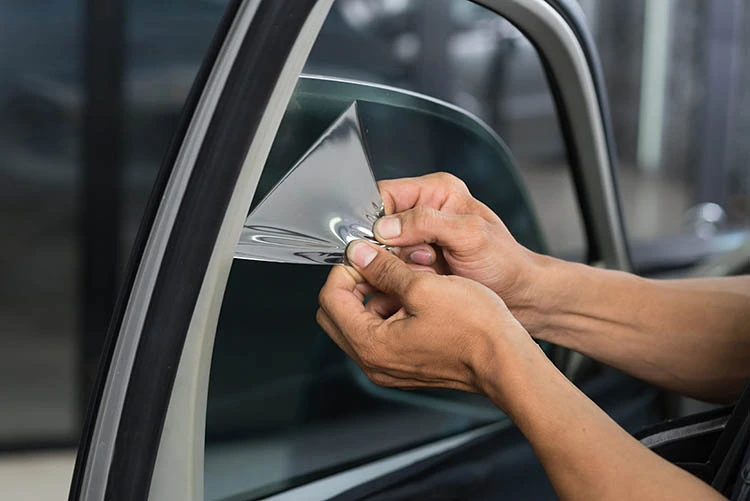How to Remove Car Window Tint | A Step-by-Step Guide
How To Remove Car Window Tint at Home
How to remove car window tint is a crucial skill for any vehicle owner. Car window tint serves various purposes, from enhancing privacy to reducing glare and heat inside the vehicle. However, over time, tinting can deteriorate, bubble, or become discolored, diminishing its effectiveness and aesthetic appeal. Knowing how to properly remove old or damaged tint is essential to maintain the functionality and appearance of your vehicle’s windows.

Gather necessary materials and tools:
- Heat gun or hairdryer
- Razor blade or sharp knife
- Ammonia-based cleaner or adhesive remover
- Cleaning cloths
- Plastic scraper
Preparation steps:
Choose a suitable location: Pick a well-lit and ventilated area like a garage or driveway.
Protect surrounding areas: Cover nearby surfaces with newspapers or plastic to prevent damage from heat or adhesive.
Ensure proper ventilation: Open windows or use fans to maintain good airflow during the removal process.
Step-by-step removal process:
Heating the tint: Use a heat gun or hairdryer to warm the tint evenly. Start from a corner and work your way across the window.
Peeling off the tint: Once the tint is heated, carefully peel it off using a razor blade or sharp knife. Pull slowly to avoid tearing the tint.
Removing adhesive residue: Apply an ammonia-based cleaner or adhesive remover to the leftover adhesive. Let it sit for a few minutes to soften the adhesive.
Cleaning the window surface: Use a plastic scraper to gently scrape off the softened adhesive. Wipe the window clean with a cloth and repeat if necessary until the window is free of residue.
Safety precautions:
Protecting hands and eyes: Wear gloves and safety goggles to shield your hands and eyes from heat and chemicals.
Proper disposal of removed tint and materials: Dispose of the removed tint and any waste materials responsibly according to local regulations.
Dealing with stubborn adhesive: If adhesive remains stubborn, reapply cleaner or remover and let it soak longer before scraping again.
How Long Does It Take to Remove Car Tint?
Factors affecting removal time:
Type and age of tint: Different types of tint adhere differently to windows, affecting removal time. Older tint may be more stubborn to remove.
Size of windows: Larger windows will naturally take longer to remove tint from.
Method of removal (professional vs. DIY): Professional removal often utilizes specialized tools and techniques, potentially speeding up the process.
Skill and experience of the person performing removal: Experience can significantly impact the efficiency of tint removal, whether DIY or professional.
Estimated timeframes for DIY removal:
Small vehicle vs. large vehicle: Removal time will vary based on the number and size of windows. A small vehicle may take around 1-2 hours, while a large vehicle could take 2-4 hours or more.
Average time per window: On average, it might take 15-30 minutes per window for DIY removal, depending on the factors mentioned above.
Comparison with professional removal timeframes:
Efficiency of professional tools and techniques: Professionals often have access to heat guns, steaming devices, and specialized solutions that can expedite the removal process. This can significantly reduce the time required compared to DIY methods.
Time-saving benefits of professional services: Professional services can complete tint removal for an entire vehicle in 1-2 hours, sometimes even less, depending on the vehicle size and tint condition. This is generally much faster than the time required for DIY removal, and the quality of the result is often higher.
Professional vs DIY Methods
Advantages and disadvantages of hiring a professional:
Quality of work:
Advantages: Professionals typically have experience and specialized tools, ensuring a higher quality removal process. They can minimize the risk of damaging the window or leaving behind adhesive residue. If you want professional guidance then Reliable Auto Glass is best in business.
Disadvantages: Quality may vary depending on the skill level of the professional hired. Some may not provide the desired results despite the cost.
Time and effort saved:
Advantages: Hiring a professional saves time and effort for the vehicle owner. Professionals can efficiently remove window tint without the need for extensive research or trial and error.
Disadvantages: Scheduling an appointment and waiting for the service may take time. Additionally, the process may require leaving the vehicle with the professional for a certain period.
Cost implications:
Advantages: While initially more expensive than DIY methods, hiring a professional can save money in the long run by avoiding potential mistakes and damage to the vehicle.
Disadvantages: Professional services can be costly, especially if multiple windows need tint removal. The price may vary depending on the service provider and location.
Advantages and disadvantages of DIY removal:
Cost-effectiveness:
Advantages: DIY removal methods are generally more cost-effective as they eliminate labor costs associated with hiring a professional.
Disadvantages: While cheaper upfront, DIY methods may incur additional costs if mistakes occur, leading to damage to the vehicle or the need to purchase specialized tools or products.
Learning curve and skill requirement:
Advantages: DIY removal allows individuals to learn a new skill and gain a sense of accomplishment from completing the task themselves.
Disadvantages: Removing window tint requires specific techniques and tools that may not be readily available or easy to use for beginners. Learning through trial and error can result in subpar results or damage to the vehicle.
Time commitment:
Advantages: DIY removal can be done at the convenience of the vehicle owner’s schedule, without the need to wait for an appointment with a professional.
Disadvantages: The process of removing window tint can be time-consuming, especially for those unfamiliar with the techniques involved. It may require multiple attempts to achieve satisfactory results.
Potential risks and mistakes:
Advantages: DIY methods allow for personal control over the removal process, potentially reducing the risk of damage caused by inexperienced professionals.
Disadvantages: Without proper knowledge and skill, DIY removal carries a higher risk of mistakes such as scratching the glass, damaging the defroster lines, or leaving adhesive residue that is difficult to remove. These mistakes can be costly to rectify.
Conclusion
The decision to remove car window tint can be approached through either hiring a professional service or undertaking a do-it-yourself (DIY) method. Hiring a professional offers the advantage of assured quality work, saving time and effort, and potentially avoiding costly mistakes. However, this comes at the expense of higher upfront costs. On the other hand, opting for a DIY approach can be cost-effective and flexible, allowing individuals to learn a new skill and work at their own pace. Feel free to contact us for any type of services or query like how to remove car window tint.
FAQs
How Do I Know If It’s Time To Remove My Car Window Tint?
You may need to remove your car window tint if it starts to bubble, fade, or peel, obstructing visibility or diminishing its aesthetic appeal.
Can I Remove Car Window Tint By Myself?
Yes, you can remove car window tint by yourself using various methods such as using a steamer, ammonia-based solution, or adhesive remover. However, it requires patience and proper technique to avoid damaging the glass.
What Tools Do I Need To Remove Car Window Tint?
Common tools include a heat gun or hairdryer, razor blade or utility knife, ammonia-based cleaner or adhesive remover, spray bottle, and microfiber cloth.
How Long Does It Take To Remove Car Window Tint?
The time required depends on factors like the method used, the condition of the tint, and the size of the windows. It can range from a few hours to a full day for complete removal.
Can I Reuse The Window Tint After Removal?
It’s not recommended to reuse the removed window tint as it may lose its adhesive properties and not adhere properly when reapplied.
Will Removing Window Tint Damage My Car Windows?
When done carefully, removing window tint shouldn’t damage the glass. However, there’s a risk of scratching the glass or damaging the defroster lines if not done properly.

